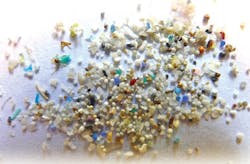Emerging contaminants in wastewater: Who should pay for treatment?
As the ultimate stewards of our environment, wastewater treatment plants are charged with a tremendous responsibility - one that they accept proudly and without reservation. But to what extent is it reasonable to hold wastewater treatment plants liable for the contaminants entering their facilities?
Consider microbeads, for example. These tiny grains of plastic are found in a wide range of personal care products from toothpaste to face wash. When rinsed down the drain, they end up at treatment plants that were not designed to handle them. Research from Oregon State University estimates that 8 trillion microbeads per day are being emitted into aquatic habitats in the United States. Another 800 trillion end up in sludge - which, if land-applied, means runoff will likely carry the beads, eventually, to the nearest waterway.
“I think we need to think a little bit more broadly in terms of what we allow to be on the shelf,” said Kerrie Romanow, director of the San José Environmental Services Department, during a panel discussion hosted by Ovivo at WEFTEC.15 in Chicago. Referring to an article about microbead contamination in the San Francisco Bay that appeared in a local newspaper, Romanow said she was fascinated by the implication that this was somehow her facility’s fault. “A manufacturer created a product, marketed it, sold it, got FDA and other approval, someone bought it, [the product] managed to get into the system, wound its way to me... but it’s my fault that it’s in the Bay?”
The approach needs to be more holistic, she suggested. “How are we looking at that product stewardship part at the front end?” she asked.
George Hawkins, general manger of DC Water and fellow panelist, agreed. EPA and federal regulations are generally built on the principle of “the polluter pays,” he pointed out. “So if a company makes [a] table, and there are pollutants that are created in the makings of the table, we charge the cost of handling those pollutants to the company so it’s put into the price of the table,” he stated. “It goes from an externality to an internality.”
Microbeads should be approached the same way, he suggested. “Our facilities aren’t polluters in that context,” he said. “We are, in fact, the most important environmental actor anywhere we exist - which is everywhere - because we’re taking all the water that everybody else uses, and on their behalf, cleaning it for them.”
Wastewater treatment plants are, in this way, performing an enormous service, he continued. Yet, he observed, it’s a very possible outcome that requirements could be imposed upon wastewater treatment facilities to try to reduce microbeads from their discharge. “It’s exactly upside down,” he said. Rather, the burden should be imposed on the maker of the product - who is making revenue from it - and they should handle the issue. “Because they’re the ones who are creating it in the first place,” he said. “It’s cheaper on that front and that’s where regulations should go in the future.”
Angela Godwin
Chief Editor, WaterWorld
More WaterWorld Current Issue Articles
More WaterWorld Archives Issue Articles

